|
Bicycle Development
Bicycles were developed from the
hobby-horses and velocipedes that appeared in France in the late 1770s.
The early machines were heavy, cumbersome, totally impractical, and were
basically toys for the wealthier members of society. In the early 1800s
Nicephore Niepce, an early photographer, built a machine that could be
steered and ridden, but much development was still necessary before the
machine could readily be used.
Around 1817 Baron
Von Drais, a wealthy German engineer, constructed a hobby
horse with an easily steerable front wheel, padded saddle
and an armrest that enabled the rider to give powerful
thrusts with his feet. The rider sat astride the vehicle
with both feet reaching the ground and propelled the machine
with a running action. Considerable numbers of the machines
were made and they became known as Draisiennes and speeds of
7 or 8m.p.h. could be easily be attained. The manufacturers
optimistically claimed that an average speed of 15m.p.h.
could be achieved on a journey, but this could be dangerous
to say the least considering the conditions of the roads at
the time. The Draisiennes weighed about 50lbs and cost
around £11, and so were very expensive at the time.
The next breakthrough in the development of the modern cycle was the
invention of pedals and cranks. Cranks first appeared on a quadricycle
in around 1819, but the first application of the crank to a bicycle was
made by Scottish blacksmith Kirkpatric McMillan in 1839. He built a
machine that used fore and aft cranks rather than rotary ones and this
became the first practical hobby horse. |
|
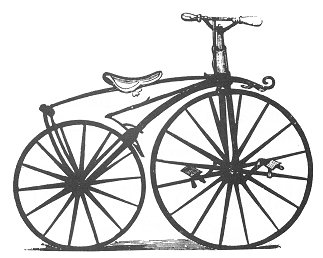
A French style
bicycle. Courtesy of the late Jim Boulton. |
Pedals didn’t appear until 1860 when
a maker of pram wheels in Paris fitted pedals and a crank to
the front wheels of his hobby horse.
There were many claims as to who was first to achieve this
breakthrough, but it is generally accepted that either
Pierre Michaux or one of his mechanics made the first
prototype. Michaux soon began producing the machines that
were known as Velocipedes. They had wrought-iron frames,
iron-tyred wooden wheels and weighed between 80 and 100lbs.
They were extremely heavy and uncomfortable to ride and
became known as “Boneshakers”. |
| They were a great improvement on
anything that had been produced before except for the now
forgotten McMillan machine.
Velocipedes were first exhibited at the Paris Exhibition of
1867 and soon versions were built in the UK. An early
manufacturer was the Coventry Sewing Machine Company, whose
representative, Rowley B. Turner visited the Paris
exhibition and persuaded the company to produce machines for
export to France. Whilst in Paris he purchased a machine, as
did Charles Spencer and J. Meynal, and they rode them from
London to Brighton, much to the interest of the general
public. |
| Mr. Turner obtained an order from a
Paris house for 500 machines and the Sewing Machine Company
obtained suitable machinery and plant for their manufacture.
They also made many improvements to the
original design and changed the name of the company to the
Coventry Machinists’ Company Limited.
The venture ran into difficulties due
to the Franco-Prussian War and so the machines were sold on
the home market. |
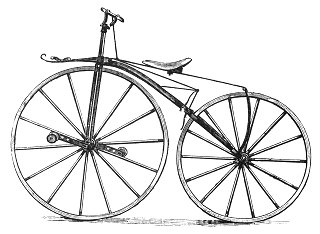
An early English bicycle.
Courtesy of the late Jim Boulton. |
| Sales were high and other
manufacturers soon appeared, mainly consisting of
blacksmiths and coach builders, and large numbers of
machines were made until the appearance of the bicycle in
about 1870. |
|
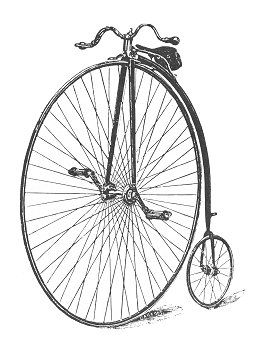
A penny farthing. Courtesy of the
late Jim Boulton. |
The first successful bicycles, known
as the “Penny Farthing” or the “High Wheeler” were a great
improvement on the “Boneshakers”. The front wheel was
greatly increased in size to produce a higher speed machine,
because a greater distance could be covered for each turn of
the pedals. At the same time the rear wheel was reduced in
diameter and solid rubber tyres were soon used along with
lightweight steel instead of heavy iron frames.
Front wheel diameters increased from 50 or 54 inches to 62
or even 64 inches for the fastest racing machines, placing
the rider a great distance from the ground. A fall could be
a serious thing, especially when going at speed and such
mishaps became known as “headers” or “imperial crowners”.
The brakes were inefficient, making stopping difficult, and
the bicycles were difficult to mount and dismount. They
could however cover long distances at speed and so became
very popular. |
| There were other alternatives for
those who preferred a lower machine. “Penny Farthings” were
not suitable for women who found them impossible to ride due
to the long skirts and dresses that were worn at the time,
and also children, whose legs couldn’t reach the pedals.
Tricycles satisfied their needs and many and varied types
were produced. Unfortunately they could easily run away on
hills or overturn. Something better was necessary and the
answer to the problem was found in rear wheel drive and
gearing. Up
until now all machines had front wheel direct drive, which
resulted in steering problems because the rider’s legs were
in the way. In September 1879 the modern type of bicycle
called the “Safety” bicycle was patented by John Lawson. It
had a small front wheel and a larger rear wheel with a pedal
and chain drive. From now on the “Penny Farthings” were
known as the “Ordinary” bicycle and would soon become a
thing of the past. The first really practical bicycle with
equally sized front and rear wheels was developed by John
Kemp and William Sutton in 1885 and built at Coventry using
the name “Rover”. The new machines became very popular and
large numbers were sold.
Another important
development was the appearance of pneumatic tyres. They were
originally invented by R.W. Thompson in 1845 but little
interest was shown until John Boyd Dunlop, a veterinary
surgeon of Belfast developed them for cycle wheels in 1888.
The Dunlop tyre initially consisted of an airtight inner
tube of indiarubber, covered with one or more canvas
coverings for protection. This was soon developed into the
Clincher tyre which allowed repairs to be easily made.
Modern looking
bicycles appeared in 1890 with the invention of the diamond
frame, thanks to Thomas Humber, and reliable variable gears
were available in 1902. All of the major components of the
modern bicycle were now in place and large numbers of
companies produced them. Ladies cycles were quickly
introduced and the industry rapidly grew with demand far
outstripping supply. Large numbers of small manufacturers
appeared to take advantage of the new market, but the bubble
quickly burst and many of them soon went into liquidation,
loosing vast sums of money in the process. Luckily the well
established companies survived and prospered to employ
thousands of men and women in a growing vehicle industry
that centred on Coventry, Nottingham and Wolverhampton.
Lighting
The first cycle lamps appeared in the
late 1860s and were sold as extras for the bicycles of the
day, which were known as velocipedes. Roads at the time were
very poor, often consisting of a dirt track with many pot
holes, and street lights were few and far between, making a
lamp essential when riding after dark.
Early lamps consisted of candle lamps and oil lamps. Candle
lamps contained a candle in a spring loaded tube, which
pushed it up as it burned. This form of lighting was never
popular with the cycling public because it gave very little
light and would be blown out in the lightest breeze. The
lamps did however have a limited success with lady cyclists
because they were clean.
Candle lamps soon disappeared due to the far superior oil
lamp, in which paraffin or coal oil was burned on a clean
open-weave wick, to allow for a good capillary action. By
1882 mechanical or winding wick holders were in use, to
allow a greater degree of flame control and oil consumption.
The lamps were very popular and continued in use until the
1950s.
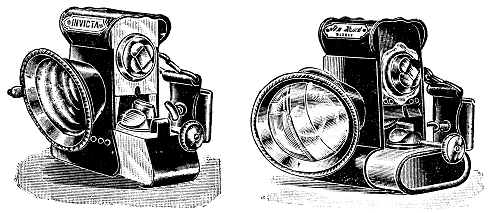
Two oil lamps from 1896.
In 1892 Canadians Willson and Moorehead
discovered a method of producing Calcium Carbide in an
electric furnace. If this was added to water, acetylene gas
was produced, which when lit gave a brilliant white light.
This was quickly applied to bicycle lighting, and the
carbide lamps produced a very powerful light source. Inside
the lamp, droplets of water fell onto the calcium carbide
that was contained in a small bowl, and the gas produced was
usually burned in front of a reflector. The rate of water
flow could be adjusted by a small screw valve, which
controlled the rate of gas production and the size of the
flame.
The lamps were only popular with enthusiastic riders because
a disagreeable smell was emitted, and the calcium hydroxide
residue, which was left behind in the bowl, had to be
frequently removed. It was also difficult to keep the filter
and burner free of dust. Carbide lamps continued to be
advertised until the late 1930s but their popularity
remained with the old school of cyclists and the dedicated
clubmen.
Electrically powered cycle lamps appeared in 1888 when
Joseph Lucas of Birmingham produced a
rechargeable accumulator powered cycle lamp. It was very
expensive, sales were poor, and by 1889 it had been
discontinued. By 1893 other similar lamps appeared and the
first dynamo-powered cycle light was introduced in about
1895. Two of the most successful products were the
“Voltalite” and the “Dynolite”, which appeared in 1899. At
the same time in America the Ever Ready company were
producing battery powered lamps with a wooden case. Their
familiar pressed steel cycle lamps appeared in 1900 and
remained much the same until recent times.
Wolverhampton's Cycle Industry
Wolverhampton’s
cycle manufacturing industry has almost been forgotten.
There were many manufacturers in the town, which during its
heyday was the third largest bicycle manufacturing centre in
the country. The town was an obvious candidate for the
setting up of the industry thanks to the large numbers of
skilled metal workers in the area and the entrepreneurial
skills of the local manufacturers, who were always willing
to fill a niche in the market.
There are two claims
to the first cycle that was produced in the City. The least
reliable was made by T. Johnson of 18 Peel Street, who
possibly built a machine in 1859. The more reliable of the
two is from Henry Clarke who built a tandem tricycle in
between 1855 and 1860 with the help of a Mr. Panter. Having
built the machine they rode it around the neighbourhood,
much to the astonishment of onlookers. |
|
Henry Clarke saw velocipedes in
Paris during his return from the Crimean war and began to export wooden
velocipede wheels to France in 1867 to 1868. At the same time he started
producing machines under the name of Cogent, which later became the
Wearwell cycle company. This was the longest surviving manufacturer of
bicycles in the town, producing them for just over 100 years.
After the
introduction of the iron tyre Mr. W.S. Lewis of Cleveland
Road, Wolverhampton developed a wheel with a concave rim so
that a solid cord of indiarubber could be fixed onto the
tyre to give a more comfortable ride. |
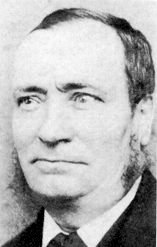
Henry Clarke |
|
In the 1870s the town was famous
for the bicycle races that took place in the grounds of the Molineux
Hotel, on the site that is now occupied by the football ground.
Large numbers of
spectators came from all over the country to watch the
events that attracted the best riders of the day. The
popularity of the races must have greatly encouraged some of
the early manufacturers.
 |
Read about
bicycle racing |
Wolverhampton also produced the
‘Rolls Royce’ of bicycles in the Sunbeam. John Marston who founded the
company, was a perfectionist, always striving for the best. His machines
were second to none, and the company was very successful. Our largest
manufacturer, Viking, had a successful racing team and large numbers of
machines were sold thanks to their many successes in competitions and
trials.
Many of the manufacturers were very
small. All of the necessary components that were needed to
build a bicycle were produced locally, and a number of
producers specialised in supplying parts to the trade. Some
of the smaller manufacturers assembled machines from the
readily available components and only required a small
workshop with maybe one or two employees.
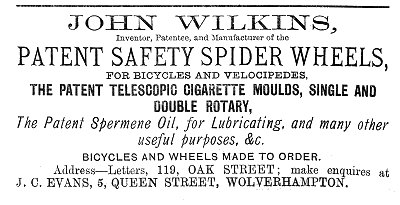
A typical manufacturer who sold parts to the
bicycle trade. Very few details of many of
the smaller companies have survived; often all that is left is adverts
in old trade directories. So the information in this section is
very patchy, to say the least. Many of the local cycle shops also made
bicycles to order, assembling them from the parts that were in stock.
 |
View a list of
local bicycle manufacturers |
By 1972 it was all over. The last factory to close
was ironically one of the first to open. Wearwell closed their Colliery
Road works in 1972, after 104 years of bicycle production. Almost all
traces of the industry have disappeared although several of the old
factory buildings still remain. Hopefully future generations will
remember that Wolverhampton was once a force to be reckoned with in the
bicycle industry.
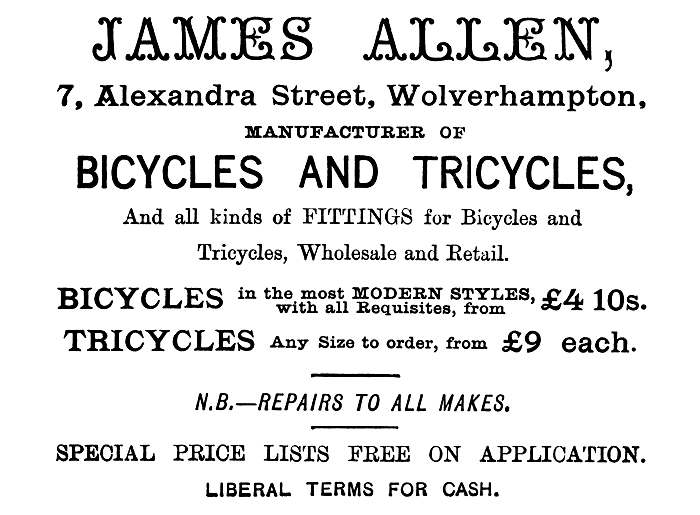
An advert from 1884.
Almost every cycle part was supplied to one manufacturer, or another,
from nuts, bolts, and washers, to tubes, frames, gears, and wheels. One
useful product that was sold to manufacturers was Pickard's lining
apparatus, which greatly simplified, and cheapened the lining process.
 |
Read about
Pickard's
lining apparatus |
References:
“Wolverhampton Cycles and
Cycling” by Jim Boulton. Published in 1988 by Brian Publications.
“Stories of Tinplate Working and
Iron Brazier’s Trade, Bicycle and Galvanising Trades, and Enamelware
Manufacture in Wolverhampton and District” by W.H. Jones. Published in
1900 by Alexander and Shepherd Ltd, London.
 |
Return to the
list
of manufacturers |
|
|



